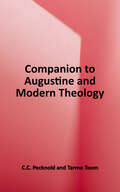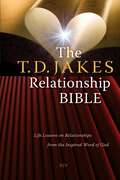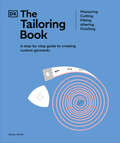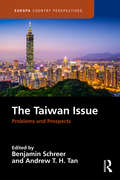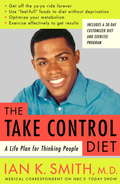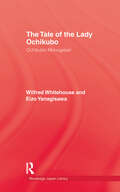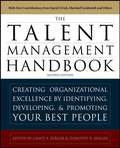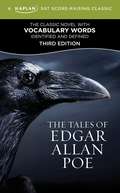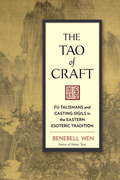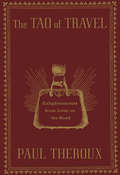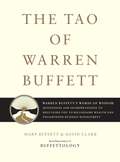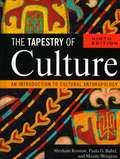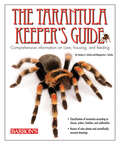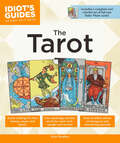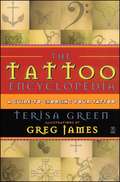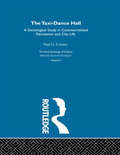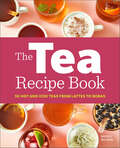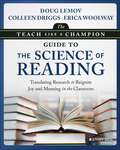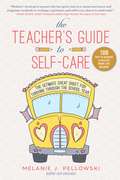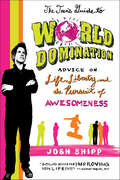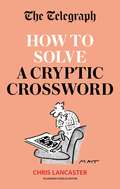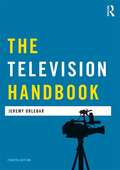- Table View
- List View
The T&T Clark Companion to Augustine and Modern Theology (Bloomsbury Companions Ser.)
by Tarmo Toom C. C. PecknoldThis book is both a theological companion to the study of Augustine, and a resource for thinking about Augustine's importance in modern theology. Each of the essays brings Augustinian depth to a broad range of contemporary theological concerns. <p><p>The volume unveils cutting-edge Augustinian scholarship for a new generation and at the same time enables readers to see the timely significance of Augustine for today. Each of the essays not only introduces readers to key themes in the Augustinian corpus but also provides readers with fresh interpretations that are fully conversant with the theological problems facing the church in our world today. <p><p>Designed as both a guide for students and a reference point for scholars, it will seek both to outline the frameworks of key Augustinian debates while at all times pushing forward fresh interpretative strategies concerning his thought.
The T.D. Jakes Relationship Bible: Life Lessons on Relationships from the Inspired Word of God
by T. D. JakesYou are invited to begin a lifelong journey to discovering God's words of truth for your life and relationships, and to discovering God Himself in the words of His Book! From Genesis to Revelation, it is clear that the Holy Bible is, in the words of Bishop T.D. Jakes, "The Greatest Love Story Ever Told." It is not a book about religion, but relationships--from the creation of a man and a woman and their intimate relationship with God in the Garden through the tragic break in that relationship at the Fall and the eventual restoration of that relationship through Jesus Christ and His death on the cross of Calvary. Our relationship with God is the foundation for our lives. If we try to build on any other relationships or things, we are building on quicksand, because at some point all of our relationships will break down. It is from our earthly relationship with God that He gives us the privilege of having healthy relationships with our spouse, our families, our friends, and countless others. *** Inside the pages of God's Word you will discover the divine instruction on life relationships that has been given to generations of people who faced the same issues and questions that you face today, addressing those questions honestly and openly and offering wise counsel for your relationships, inspiration for your needs, comfort for your sorrows, guidance for your confusion, and hope for your discouragement. In The Relationship Bible, you will find the following features from Bishop Jakes: * A 32-page Introduction that sets forth "The Greatest Love Story Ever Told" along with helps to understanding the Bible and guides to answering life's relationship problems. * Reflections of God's Heart--Over 20 pages of articles that continue to develop God's love relationship with mankind. * Lessons of the Heart--Over 80 pages of life lesson articles that address a wide range of relationship issues. * Heartbeats--25 articles that demonstrate how to build relationships. * Heartbreakers--25 articles that demonstrate how relationships are damaged. * Heart Murmurs--10 powerful prayers for your personal relationships. * Words of Jesus in Red * Concordance * One-Year Bible Reading Plan
The Tailoring Book: Measuring. Cutting. Fitting. Altering. Finishing
by Alison SmithWhether you want to alter a vintage jacket or create a full-tailored suit, this tailoring reference guide has everything you need to produce elegant, bespoke garments that last a lifetime.With over 80 step-by-step techniques on measuring, cutting, altering, and finishing, this is the only book you will need to create and alter a tailored garment.Alison Smith MBE is one of the world's leading tailoring experts, and in her new book, she reveals trade secrets and all the practical know-how necessary to master this heritage craft. The Tailoring Book is the latest title in Smith's best-selling sewing series. It covers everything from choosing patterns and fabrics to fitting and construction, including techniques that can be applied to both womens- and menswear.With this book, you can learn how to:-Tailor garments by selecting the right tools to create a toile and picking the perfect hand stitch.-Follow 10 detailed garment projects to create shirts, jackets, coats, and trousers-Master the techniques of tailoring with step-by-step instructions and downloadable patterns that guide you through every part of the processThis book includes key equipment and techniques, garment projects with clear step-by-step processes and downloadable patterns, and tips on repairs and alterations. It takes the reader from the basics through to couture techniques.
The Taiwan Issue: Problems and Prospects (Europa Country Perspectives)
While global attention has been focused on other regional issues, such as China-US tensions and North Korea’s nuclear ambitions, little attention has been paid to Taiwan. Yet the so-called Taiwan issue, namely the continued separation of the island from mainland China, remains a major regional security challenge that could potentially spark direct conflict involving the USA, China and Japan, the three largest economies in the world, two of which are nuclear powers. Although Taiwan has continued to find opportunities to maintain the current status quo despite a deteriorating geo-strategic environment as a result of the rise of China and the uncertainties of the Trump Administration, its room for manoeuvre continues to narrow. This volume examines the challenges and evaluates the prospects for preventing conflict on the Taiwan Strait, by focusing on the political conditions that Taiwan faces internally and externally.
The Take-Control Diet: A Life Plan for Thinking People
by Ian SmithFrom the bestselling author of ShredThe Take-Control Diet aims to make you the expert on your body.Dr. Ian Smith delivers the final word on dieting for the fad-weary reader who wants the truth about permanent weight loss. The Take-Control Diet explains the real science of how your body manages energy, why crash diets and trendy programs sabotage your chances of success, and how you can get off the yo-yo ride forever.Dr. Smith offers a diet and exercise program that allows you to eat without feeling deprived, or adopting an entirely specialized diet, and that helps you use both anaerobic and aerobic exercise for maximum weight loss results. He explains how to calculate your own individual food-and-exercise equation in order to lose the ideal amount of weight per week. The Take-Control Diet equips you with the facts so that you can approach your health and fitness goals psychologically fortified for the task. Understanding common myths about dieting will give you the knowledge you need to resolve your weight issues for good. Did you know that, contrary to the recommendations of many popular diets, eating too much protein could seriously damage your health? That it is impossible to convert fat to muscle? That starving yourself slows your metabolism and causes your body to store energy as fat? That no foods appreciably increase your metabolism? That chronic, yo-yo dieting makes weight loss increasingly difficult?Dr. Smith explains the causes of overweight, the health concerns of dieting, how metabolism and genetics factor in to weight control, and what you can do to work with, rather than against, your body&’s processes. Many diets dictate a program that might work—if it works at all—only as long as you can adhere to radical and unnatural habits. The Take-Control Diet, instead, equips you to design your own eating and exercise plan—one that accommodates your preferences, your daily routine, and your particular weight loss hurdles. Losing weight will not only help you look your best but also reduce your risk of heart disease, diabetes, and cancer—in addition to improving your overall energy level and ability to fight illness. Dr. Smith offers a plan, based on extensive research and his personal work with patients, that respects your intelligence and empowers you to win the battle with overweight. The Take-Control Diet is one hundred percent free of unrealistic promises, poor science, and far-fetched gimmicks—and one hundred percent yours for life.
The Tale of the Lady Ochikubo: Ochikubo Monogatari (Routledge Japan Library)
by Eizo Yanagisawa Wilfred WhitehouseThis family saga of a wicked stepmother has been called the world’s first novel. Written during the 10th century Heian Era and first translated into English and published by Kegan Paul in 1934, it follows the changing fortunes of the heroine, Lady Ochikubo, who is forced to live almost as a servant in her noble father’s house while the stepmother gives preference in all things to her own daughters.
The Talent Management Handbook
by Dorothy Berger Lance A. BergerUpdated for today's global workplaces, "The Talent Management Handbook" offers a complete system managers can use to maximize ROI from any organization's investment in human capital.
The Tales of Edgar Allan Poe
by Edgar Allan PoeVocabulary is a critical part of studying for the SATs. Memorizing words that are written on flashcards can be difficult because they are not put in the context of a sentence. <P><P>Kaplan's SAT Score-Raising Classics make learning SAT vocabulary words easier and more enjoyable for students. Classic novels that are taught throughout high school can now be read while learning vocabulary words that frequently appear on the SAT exam. <P>Designed for easy use, these books feature the actual text on one side of the page, with the word definitions on the opposite side. In addition, the vocabulary words are in easy-to-spot bold typeface throughout. <P>Each Kaplan SAT Score-Raising Classic features:* The complete text of the classic novel* Hundreds of vocabulary words tested on the SAT exam* Definitions for each highlighted work on the facing page* A pronunciation guide* An index for easy reference* A teachers' guide that includes instructional suggestions, in-class activities, and homework assignments posted on our web site: kaptest.com <P>Kaplan's SAT Score-Raising Classics series give readers get an invaluable learning tool and an enjoyable reading experience.
The Tao of Craft: Fu Talismans and Casting Sigils in the Eastern Esoteric Tradition
by Benebell WenFor the first time in English, Benebell Wen reveals the rich history and theoretical principles underlying the ancient practice of crafting Fu talismans, or magical sigils, in the Chinese Taoist tradition and gives detailed instructions for modern practitioners who would like to craft their own Fu. Fu talismans are ideograms and writings typically rendered on paper and empowered by means of invocations, ritual, and transferences of energy, or Qi. Talismans can be used for many purposes, such as strengthening or weakening personality characteristics, finding love, earning more money, or easing emotional tensions in the home. The Tao of Craft shows how metaphysical energy can be harnessed to amplify, strengthen, weaken, dispel, or block other metaphysical energy and to rectify perceived imbalances in the material plane. Supported by an abundance of detailed charts and images, this book serves as a step-by-step handbook that gives readers the knowledge and confidence to craft their own Fu talismans for personal empowerment. Wen, author of Holistic Tarot, delves into historic and cultural contexts of the Fu, from the neolithic period of Chinese history to contemporary practices of esoteric Taoism. Providing a solid foundation in the principles of Eastern spellcrafting, she highlights the blending of Taoist metaphysical practices with Western approaches to magic by pointing out eclectic, integrating, and harmonizing facets from other cultures and religions. Historically, Fu talismans were used by medieval Chinese for alleviating illness; averting misfortune, magical attacks, and curses; defending against assaults; and avoiding poverty. This book shows Western practitioners that the skill and knowledge to develop an interactive relationship with spirit realms are still available to them today, and serves as a practical handbook for accumulating Qi energy from sources in the environment and channeling it in concentrated form into their own Fu talismans.
The Tao of Travel: Enlightenments from Lives on the Road
by Paul TherouxThe acclaimed author explores the greatest travel writing by literary adventurers from Freya Stark and James Baldwin to Nabokov and Hemmingway.Paul Theroux celebrates fifty years of wandering the globe with this meditative journey through the books that shaped him as a reader and traveler. Part philosophical guide, part miscellany, part reminiscence, The Tao of Travel enumerates &“The Contents of Some Travelers&’ Bags&” and exposes &“Writers Who Wrote about Places They Never Visited&”; tracks extreme journeys in &“Travel as an Ordeal&” and highlights some of &“Travelers&’ Favorite Places.&” Excerpts from the best of Theroux&’s own work are interspersed with selections from travelers both familiar and unexpected, including J.R.R. Tolkien, Samuel Johnson, Eudora Welty, Evelyn Waugh, Isak Dinesen, Charles Dickens, Henry David Thoreau, Pico Iyer, Mark Twain, Anton Chekhov, Bruce Chatwin, John McPhee, Peter Matthiessen, Graham Greene, Paul Bowles, and many more.
The Tao of Warren Buffett: Warren Buffett's Words of Wisdom: Quotations and Interpretations to Help Guide You to Billionaire Wealth and Enlightened Business Management
by Mary Buffett David ClarkA collection of pithy and inspiring sayings from America's favorite businessman that reveal his secrets of success Like the sayings of the ancient Chinese philospher Lao-tzu, Warren Buffett's worldly wisdom is deceptively simple and enormously powerful in application. In The Tao of Warren Buffett, Mary Buffett -- author of three books on Warren Buffett's investment methods -- joins noted Buffettologist and international lecturer David Clark to bring you Warren Buffett's smartest, funniest, and most memorable sayings with an eye toward revealing the life philosophy and the investment strategies that have made Warren Buffett, and the shareholders of Berkshire Hathaway, so enormously wealthy. Warren Buffett's investment achievements are unparalleled. He owes his success to hard work, integrity, and that most elusive commodity of all, common sense. The quotations in this book exemplify Warren's practical strategies and provide useful illustrations for every investor -- large or small -- and models everyone can follow. The quotes are culled from a variety of sources, including personal conversations, corporate reports, profiles, and interviews. The authors provide short explanations for each quote and use examples from Buffett's own business transactions whenever possible to illustrate his words at work. As Warren says: "You should invest in a business that even a fool can run, because someday a fool will. " "With enough inside information and a million dollars, you can go broke in a year. " "No matter how great the talent or effort, some things just take time: You can't produce a baby in one month by getting nine women pregnant. " "Our method is very simple. We just try to buy businesses with good-to-superb underlying economics run by honest and able people and buy them at sensible prices. That's all I'm trying to do. " The Tao of Warren Buffett inspires, amuses, sharpens the mind, and offers priceless investment savvy that anyone can take to the bank. This irresistibly browsable and entertaining book is destined to become a classic.
The Tapestry Of Culture: An Introduction To Cultural Anthropology (Ninth Edition)
by Abraham Rosman Paula G. Rubel Maxine K. Weisgrau<P>The most exciting thing about anthropology is that it enables the student to become acquainted with people of different cultures. <P>The Tapestry of Culture provides the student with the basic concepts necessary to understand these different cultures while showing that cultural variations occur within certain limits. <P>Though the forces of globalization have caused cultures of the world around us to become increasingly similar, the book shows that people nevertheless cling to ethnic identities, and their cultural distinctiveness.
The Tarantula Keeper's Guide: Comprehensive Information on Care, Housing, and Feeding
by Stanley A. Schultz Marguerite J. SchultzTerrarium hobbyists and arachnid lovers will rejoice at this comprehensive guide on tarantulas! The Tarantula Keeper's Guide provides in-depth information on their biology and advice on housing and caring for pet tarantulas.Tarantulas are small and easy-to-maintain exotic pets that are fun and captivating to watch. The Tarantula Keeper's Guide includes detailed information on the natural history and biology of these fascinating creatures. This spider book is filled with color photos, scientifically accurate line art, and detailed care instructions. It's no wonder that The Tarantula Keeper's Guide is considered the "Bible of Arachnoculture" by hobbyists and arachnid enthusiast!
The Tarot: The Tarot (Idiot's Guides)
by Avia VeneficaIncluded with the book is a complete deck of full-size original Rider-Waite cards! Complete with beautiful, full-color photography, Idiot's Guides: The Tarot is a book that uses clear, concise instructions to walk beginning readers through the meanings of each of the cards, and how they can be interpreted when they appear in a spread. Accompanying the Tarot's core meanings and keywords for each card are "Quick Reads"-a shortcut to a card's meaning for the subjects most people want to know: Love, Money, Family, and Career. Also included is detailed information on how to lay and interpret the five basic Tarot spreads, as well as spreads for specific questions.
The Tasha Tudor Cookbook: Recipes and Reminiscences from Corgi Cottage
by Tasha Tudor"Tasha Tudor, beloved children's book author and illustrator, has at last written her long-awaited cookbook. In words and the enchanting watercolors for which she is renowned, she shares the recipes she has gathered over a lifetime - some that have been passed down for generations and some that she created specially for her children and grandchildren. These traditional recipes recall an old-fashioned New England lifestyle and summon up Tasha Tudor's own warm family memories, which she shares here with her readers." "Tasha Tudor's recipe collection includes summery picnic salads, hearty winter soups, and breakfast treats like Great-Grandmother Tudor's Cornbread, Blueberry Coffee Cake, and Butterscotch Rolls. Her main dishes - Roast Chicken with tarragon and sage, vegetable-laden Beef Stew, and Salmon served with homegrown peas - are the prelude to her irresistibly rich desserts, including a luscious dark chocolate torte and English Toffee Bars." "At Tasha Tudor's Corgi Cottage, Christmas celebrations are the high point of the year, filled with the kind of food and wholesome fun that harks back to an earlier time. Her recipes bring family and friends together to make her well-known gingerbread Christmas tree ornaments (which have been displayed on the White House tree), and such seasonal favorites as thumb cookies and pulled taffy for wrapping as gifts or for putting in paper cornucopias to hang on the tree." "All of these authentic, tried-and-true recipes are presented for the first time with some fifty original watercolor and pen-and-ink drawings in this beguiling keepsake kitchen companion."--BOOK JACKET.Title Summary field provided by Blackwell North America, Inc. All Rights Reserved
The Task-Centred Book (The Social Work Skills Series)
by Mark Doel Peter MarshTask centred social work is one of the best known and most strongly supported approaches to social work practice. This text is a radical departure from traditional literature on social work methods. The main reference point is the voice of practitioners, service users and carers, as researched and developed by the authors over twenty years. Case studies are used throughout the book to build on the experiences of practitioners and the people with whom they have worked, demonstrating practical skills for: study and analysis teaching and learning practicing task-centred social work review and continuing development. The Task-Centred Book is a core text for both undergraduate social work courses and continuing professional development training, as well as being a practical book for the active professional which will support the development and implementation of task-centred practice.
The Tattoo Encyclopedia: A Guide to Choosing Your Tattoo
by Terisa GreenA unique illustrated reference on the origins and meanings of nearly one thousand tattoo symbols that serves as a guide for choosing a personal image and provides a fascinating look at the tattoo as a work of art. Tattoos continue to move into the mainstream and grow in popularity with each passing day. For people contemplating getting a tattoo, however, the choice of images can be overwhelming. A comprehensive, informative exploration of the colorful world of tattoos,The Tattoo Encyclopediapresents concise descriptions of symbols both common and unusual and sheds light on their historic, religious, and cultural significance. Organized in a convenient A-to-Z format, cross-referenced, indexed by category, and illustrated with three hundred samples of authentic tattoo line art, this book features a stunning array of images ranging from ancient Buddhist and Chinese designs to those sported by twenty-first-century bikers. The definition of each symbol includes the widely accepted interpretation based on historical fact and cultural source, as well as various interpretations that have developed across different cultures and time periods. Whether choosing a personally significant tattoo, wanting to learn more about a symbol, or simply being interested in tattoos as a form of art and body decoration, readers will discover the richness of tattoo culture inThe Tattoo Encyclopedia.
The Taxi-Dance Hall (The\making Of Sociology Ser.)
by Paul G. CresseyFirst published in 2003. This is Volume II of eight in the Early Sociology of Culture collection and offers a sociological study on the commercialized recreation. Paul G. Cressey while serving as a case-worker and special investigator for the Juvenile Protective Association was requested during the summer of 1925 to report upon the new and then quite unfamiliar closed dance halls. This book is in a sense the outgrowth of those assignments.
The Tea Recipe Book: 50 Hot and Iced Teas from Lattes to Bobas
by Nicole WilsonTake tea time to the next level with this delightful tea recipe bookTea just might be the perfect beverage. There's always a type or blend to fit your mood, whether you want to curl up with a hot cup of Earl Grey or cool off with an Iced Peach White Tea. With this teas book in your collection, you can celebrate the diversity of flavors as you learn how to make an array of tea drinks and tea-infused snacks.Give the perfect tea gift for tea lovers with:Brewing basics—Learn all about infusions, decoctions, making concentrates, and more as you delve into the fundamentals of optimal tea brewing.Herbal recipes and more —Indulge in 50 recipes ranging from a piping hot mug of Chocolate Chai to a refreshing glass of Thai Bubble Tea, plus some teatime treats to go with them!The ideal cup—Prepare any tea to perfection with tips on temperature, steep time, and using just the right amount of leaves for each drink.Prepare specialty tea drinks at home with the book of tea that makes each pot perfect.
The Teach Like a Champion Guide to the Science of Reading: Translating Research to Reignite Joy and Meaning in the Classroom
by Doug Lemov Erica Woolway Colleen DriggsThe most comprehensive and practical guide to understanding and applying the science of reading to improve literacy instruction. After effectively teaching phonics in the early grades, what does the science of reading tell us should happen in literacy classes? The Teach Like a Champion Guide to the Science of Reading by Doug Lemov, Erica Woolway, and Colleen Driggs, addresses the pressing challenges educators face in effectively incorporating the Science of Reading into their instruction once students already know how to decode. By offering actionable guidance grounded in seven evidence-based principles, this book helps teachers elevate their instructional practices and better prepare students to be lifelong readers and thinkers. Grounded in proven classroom instruction, the book focuses on techniques that can allow teachers to use the science as effectively and actionably as possible. The Teach Like a Champion Guide to the Science of Reading is enhanced with more than 50 video clips from the classroom and covers ways to practically apply the Science of Reading. The book describes the often overlooked role of fluency in reading comprehension, even into the high school years; the profound importance of managing and socializing attention in an age of technology; the central role of background knowledge in understanding text; and the doubly important role of teaching vocabulary as a form of knowledge. It adds a discussion of how writing can make students better readers and how important it is that reading classes focus on reading actual books—great ones, ideally. And it closes with a discussion of close reading and the challenge of preparing students to rise to the challenge of complex text. Inside the book: An innovative approach to building and reinforcing background knowledge in reading Over 50 video demonstrations of effective teaching techniques Sample lesson plans and materials for immediate classroom application The Teach Like a Champion Guide to the Science of Reading is essential for educators, literacy coaches, and administrators who aim to foster rigorous literacy instruction in their classrooms and schools. This guide shows you how to implement techniques that ensure students find joy in reading and become better, wiser, more engaged and more motivated readers, both in their classrooms and in their lives beyond.
The Teacher's Guide to Self-Care: The Ultimate Cheat Sheet for Thriving through the School Year
by Melanie J. PellowskiAn inspirational memento for the teacher in your life, with quotes, anecdotes, and advice from real educators about teaching philosophies, trends, and so much more! Teachers run on adrenaline, good vibes, and big dreams. They&’re often so busy helping our little ones that they forget about the little things they need to be happy on their own time. From simple drink recipes to humorous anecdotes about pop culture and the history of education, The Teacher&’s Guide to Self-Care is the perfect cheat sheet for maintaining sanity, looking smart, and feeling fabulous throughout the dog days of the school year. Topics include: Past, present, and future teaching trendsCreative ideas for decorating your classroomTeacher lingoHow to manage your free time beyond the classroomAnd so much more! Every teacher who sheds a tear on the last day of summer can share a smile on the first day of school with a confidence-boosting, adorable guidebook that reminds them they aren&’t alone.
The Teen's Guide to World Domination: Advice on Life, Liberty, and the Pursuit of Awesomeness
by Josh ShippJosh Shipp has been serving up a healthy dose of "advice with an attitude" to millions of teens for over a decade, in front of packed auditoriums across the country. For the first time ever, Josh is pulling together all of his unique advice for "world domination" into a must-have survival guide. Hilarious, inspirational, and authentic, Josh offers golden nuggets of wisdom for everything that has you freaking out (pretty much all the stuff you can't fathom addressing with Mom and Dad). So, summon your inner hero and learn to dominate the seven "villains" that are keeping you from awesomeness. GHOSTS: All your painful memories and bad mistakes, which are holding you back and causing self-doubt. Confront them once and for allNINJAS: Back-stabbing "friends" who earn your trust to fulfill their own agendas. Call them out and they won't stand a chancePIRATES: Bullies and bad boyfriends who take advantage of you. Write them off and tune them outROBOTS: Well-intentioned but misguided grown-ups, who want to "program" you to be like them. Understand how parents, teachers, and counselors operate to improve your communicationVAMPIRES: Negative influences and addictions, which draw you in and steal your identity. Regain your self-esteem before you get bitZOMBIES: Chronic complainers who drag you down with their pessimism. The best zombie-repellant is gratitude! Learn that it's not what happens to you, it's how you respondPUPPIES: They seem all fun and innocent on the surface, but often blindside you with hidden consequences. Learn how to think smart about money, your hot girlfriend, and other temptations
The Telegraph: Mastering cryptic crosswords made easy
by Telegraph Media Group LtdHave you always wondered how to do a cryptic crossword?Solving one maybe easier than you think thanks to this book.The Telegraph's Puzzle Editor, Chris Lancaster, shows how to crack cryptic crosswords in an easy-to-follow way.This simple-to-use guide will help you solve any cryptic crossword, whether you're a complete beginner or a puzzler seeking to expand your knowledge. This book features:- Explanations of the common clue devices, including double definitions, hidden clues, charades, subtractions, homophones and container-and-contents clues- Work-throughs of practice crosswords- Tips for spotting each variety of clue - The top 10 solving tips you need to know- Advice on reference materials and taking your puzzling to the next level- Chris's top-12 solving tips- Appendices of useful lists including single-letter abbreviations and a glossary of common 'crosswordese'Whether you're a novice or an inveterate puzzle lover, this is the perfect crossword solving guide for all.
The Telegraph: Mastering cryptic crosswords made easy (The Telegraph Puzzle Books)
by Telegraph Media Group LtdHave you always wondered how to do a cryptic crossword?Solving one maybe easier than you think thanks to this book.The Telegraph's Puzzle Editor, Chris Lancaster, shows how to crack cryptic crosswords in an easy-to-follow way.This simple-to-use guide will help you solve any cryptic crossword, whether you're a complete beginner or a puzzler seeking to expand your knowledge. This book features:- Explanations of the common clue devices, including double definitions, hidden clues, charades, subtractions, homophones and container-and-contents clues- Work-throughs of practice crosswords- Tips for spotting each variety of clue - The top 10 solving tips you need to know- Advice on reference materials and taking your puzzling to the next level- Chris's top-12 solving tips- Appendices of useful lists including single-letter abbreviations and a glossary of common 'crosswordese'Whether you're a novice or an inveterate puzzle lover, this is the perfect crossword solving guide for all.
The Television Handbook
by Jeremy OrlebarThe Television Handbook is a critical introduction to the practice and theory of television. The book examines the state of television today, explains how television is made and how production is organised, and discusses how critical thinking about programmes and genres can illuminate their meanings. This book also explores how developments in technology and the changing structure of the television industry will lead the medium in new directions. The Television Handbook gives practical advice on many aspects of programme making, from an initial programme idea through to shooting and the post-production process. The book includes profiles giving insight into how personnel in the television industry - from recent graduates to television executives - think about their work. The Television Handbook offers chapters on the vigorous debates about what is meant by quality television, how news and factual programmes are responding to interactive technologies, and how formats such as Reality/Talent TV have risen in prominence. It also considers how drama, sport and music television can be discussed and interpreted. The Television Handbook includes: Profiles of TV news and drama producers, editors and TV studio personnel Case histories of important TV genres and series Practical programme making advice Explanations of key theoretical perspectives in television studies
